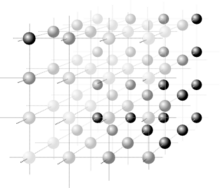Splatting
Splatting (from English to splatter : "splash") is a rendering technique of volume graphics . She regards the voxels as small balls of color that are thrown onto the image plane and burst there.
classification
In volume graphics, three-dimensional objects are described by voxel data. These are generated by randomly reading a material value at many points inside and outside the real object. If this is done at regular intervals, the result is a three-dimensional grid of voxels (see Fig. 1), also called volumes.
The aim of rendering is now to compute images from such a voxel grid; mathematically one speaks of a projection from the three-dimensional space into the (two-dimensional) image plane.
In the past, various techniques were developed for this purpose, namely volume raycasting, shear warp, 3D texture mapping and splatting. Splatting is an object-based rendering technique: while image-based techniques such as volume raycasting start from the image to be ultimately generated and process this point by point, splatting starts from the object and processes this voxel by voxel.
Advantages and disadvantages compared to other volume representations
In contrast to ray casting, this is an object-space-oriented process (object order). The data values are converted into color values and then mixed (pre-classification), not the other way around (post-classification). The computational effort involved in splatting depends on the position of the image plane.
